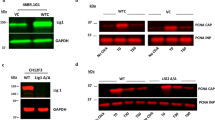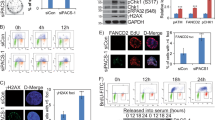Abstract
Proper cell cycle-dependent expression of replication-dependent histones is essential for packaging of DNA into chromatin during replication. We previously showed that cyclin-dependent kinase-9 (CDK9) controls histone H2B monoubiquitination (H2Bub1) to direct the recruitment of specific mRNA 3′ end processing proteins to replication-dependent histone genes and promote proper pre-mRNA 3′ end processing. We now show that p53 decreases the expression of the histone-specific transcriptional regulator Nuclear Protein, Ataxia-Telangiectasia Locus (NPAT) by inducing a G1 cell-cycle arrest, thereby affecting E2F-dependent transcription of the NPAT gene. Furthermore, NPAT is essential for histone mRNA 3′ end processing and recruits CDK9 to replication-dependent histone genes. Reduced NPAT expression following p53 activation or small interfering RNA knockdown decreases CDK9 recruitment and replication-dependent histone gene transcription but increases the polyadenylation of remaining histone mRNAs. Thus, we present evidence that the induction of a G1 cell-cycle arrest (for example, following p53 accumulation) alters histone mRNA 3′ end processing and uncover the first mechanism of a regulated switch in the mode of pre-mRNA 3′ end processing during a normal cellular process, which may be altered during tumorigenesis.
This is a preview of subscription content, access via your institution
Access options
Subscribe to this journal
Receive 50 print issues and online access
$259.00 per year
only $5.18 per issue
Buy this article
- Purchase on Springer Link
- Instant access to full article PDF
Prices may be subject to local taxes which are calculated during checkout






Similar content being viewed by others
References
Abba MC, Hu Y, Sun H, Drake JA, Gaddis S, Baggerly K et al. (2005). Gene expression signature of estrogen receptor alpha status in breast cancer. BMC Genomics 6: 37.
Carvajal D, Tovar C, Yang H, Vu BT, Heimbrook DC, Vassilev LT . (2005). Activation of p53 by MDM2 antagonists can protect proliferating cells from mitotic inhibitors. Cancer Res 65: 1918–1924.
Choi HS, Choi BY, Cho YY, Mizuno H, Kang BS, Bode AM et al. (2005). Phosphorylation of histone H3 at serine 10 is indispensable for neoplastic cell transformation. Cancer Res 65: 5818–5827.
Collart D, Ramsey-Ewing A, Bortell R, Lian J, Stein J, Stein G . (1991). Isolation and characterization of a cDNA from a human histone H2B gene which is reciprocally expressed in relation to replication-dependent H2B histone genes during HL60 cell differentiation. Biochemistry 30: 1610–1617.
DeRan M, Pulvino M, Greene E, Su C, Zhao J . (2008). Transcriptional activation of histone genes requires NPAT-dependent recruitment of TRRAP-Tip60 complex to histone promoters during the G1/S phase transition. Mol Cell Biol 28: 435–447.
Gao G, Bracken AP, Burkard K, Pasini D, Classon M, Attwooll C et al. (2003). NPAT expression is regulated by E2F and is essential for cell cycle progression. Mol Cell Biol 23: 2821–2833.
Huen MS, Grant R, Manke I, Minn K, Yu X, Yaffe MB et al. (2007). RNF8 transduces the DNA-damage signal via histone ubiquitylation and checkpoint protein assembly. Cell 131: 901–914.
Johnsen SA, Subramaniam M, Monroe DG, Janknecht R, Spelsberg TC . (2002). Modulation of transforming growth factor beta (TGFbeta)/Smad transcriptional responses through targeted degradation of TGFbeta-inducible early gene-1 by human seven in absentia homologue. J Biol Chem 277: 30754–30759.
Kirsh AL, Groudine M, Challoner PB . (1989). Polyadenylation and U7 snRNP-mediated cleavage: alternative modes of RNA 3′ processing in two avian histone H1 genes. Genes Dev 3: 2172–2179.
Kranz D, Dobbelstein M . (2006). Nongenotoxic p53 activation protects cells against S-phase-specific chemotherapy. Cancer Res 66: 10274–10280.
Kranz D, Dohmesen C, Dobbelstein M . (2008). BRCA1 and Tip60 determine the cellular response to ultraviolet irradiation through distinct pathways. J Cell Biol 182: 197–213.
Lemm I, Girard C, Kuhn AN, Watkins NJ, Schneider M, Bordonné R et al. (2006). Ongoing U snRNP biogenesis is required for the integrity of Cajal bodies. Mol Biol Cell 17: 3221–3231.
Lohr K, Moritz C, Contente A, Dobbelstein M . (2003). p21/CDKN1A mediates negative regulation of transcription by p53. J Biol Chem 278: 32507–32516.
Ma T, Van Tine BA, Wei Y, Garrett MD, Nelson D, Adams PD et al. (2000). Cell cycle-regulated phosphorylation of p220(NPAT) by cyclin E/Cdk2 in Cajal bodies promotes histone gene transcription. Genes Dev 14: 2298–2313.
Mailand N, Bekker-Jensen S, Faustrup H, Melander F, Bartek J, Lukas C et al. (2007). RNF8 ubiquitylates histones at DNA double-strand breaks and promotes assembly of repair proteins. Cell 131: 887–900.
Martinez I, Wang J, Hobson KF, Ferris RL, Khan SA . (2007). Identification of differentially expressed genes in HPV-positive and HPV-negative oropharyngeal squamous cell carcinomas. Eur J Cancer 43: 415–432.
Marzluff WF, Wagner EJ, Duronio RJ . (2008). Metabolism and regulation of canonical histone mRNAs: life without a poly(A) tail. Nat Rev Genet 9: 843–854.
Narita T, Yung TM, Yamamoto J, Tsuboi Y, Tanabe H, Tanaka K et al. (2007). NELF interacts with CBC and participates in 3′ end processing of replication-dependent histone mRNAs. Mol Cell 26: 349–365.
Pirngruber J, Shchebet A, Johnsen SA . (2009a). Insights into the function of the human P-TEFb component CDK9 in the regulation of chromatin modifications and co-transcriptional mRNA processing. Cell Cycle 8: 3636–3642.
Pirngruber J, Shchebet A, Schreiber L, Shema E, Minsky N, Chapman RD et al. (2009b). CDK9 directs H2B monoubiquitination and controls replication-dependent histone mRNA 3′ end processing. EMBO Rep 10: 894–900.
Rappold I, Iwabuchi K, Date T, Chen J . (2001). Tumor suppressor p53 binding protein 1 (53BP1) is involved in DNA damage-signaling pathways. J Cell Biol 153: 613–620.
Saintigny Y, Delacôte F, Varès G, Petitot F, Lambert S, Averbeck D et al. (2001). Characterization of homologous recombination induced by replication inhibition in mammalian cells. EMBO J 20: 3861–3870.
Shin S, Rossow KL, Grande JP, Janknecht R . (2007). Involvement of RNA helicases p68 and p72 in colon cancer. Cancer Res 67: 7572–7578.
Simone C, Bagella L, Bellan C, Giordano A . (2002). Physical interaction between pRb and cdk9/cyclinT2 complex. Oncogene 21: 4158–4165.
Sims III RJ, Millhouse S, Chen CF, Lewis BA, Erdjument-Bromage H, Tempst P et al. (2007). Recognition of trimethylated histone H3 lysine 4 facilitates the recruitment of transcription postinitiation factors and pre-mRNA splicing. Mol Cell 28: 665–676.
Su C, Gao G, Schneider S, Helt C, Weiss C, O'Reilly MA et al. (2004). DNA damage induces downregulation of histone gene expression through the G1 checkpoint pathway. EMBO J 23: 1133–1143.
Takahashi Y, Rayman JB, Dynlacht BD . (2000). Analysis of promoter binding by the E2F and pRB families in vivo: distinct E2F proteins mediate activation and repression. Genes Dev 14: 804–816.
Vairo G, Livingston DM, Ginsberg D . (1995). Functional interaction between E2F-4 and p130: evidence for distinct mechanisms underlying growth suppression by different retinoblastoma protein family members. Genes Dev 9: 869–881.
Wagner EJ, Burch BD, Godfrey AC, Salzler HR, Duronio RJ, Marzluff WF . (2007). A genome-wide RNA interference screen reveals that variant histones are necessary for replication-dependent histone pre-mRNA processing. Mol Cell 28: 692–699.
Wang H, Zhai L, Xu J, Joo HY, Jackson S, Erdjument-Bromage H et al. (2006). Histone H3 and H4 ubiquitylation by the CUL4-DDB-ROC1 ubiquitin ligase facilitates cellular response to DNA damage. Mol Cell 22: 383–394.
Wei Y, Jin J, Harper JW . (2003). The cyclin E/Cdk2 substrate and Cajal body component p220(NPAT) activates histone transcription through a novel LisH-like domain. Mol Cell Biol 23: 3669–3680.
Yan B, Yang X, Lee TL, Friedman J, Tang J, Van Waes C et al. (2007). Genome-wide identification of novel expression signatures reveal distinct patterns and prevalence of binding motifs for p53, nuclear factor-kappaB and other signal transcription factors in head and neck squamous cell carcinoma. Genome Biol 8: R78.
Ye X, Wei Y, Nalepa G, Harper JW . (2003). The cyclin E/Cdk2 substrate p220(NPAT) is required for S-phase entry, histone gene expression, and Cajal body maintenance in human somatic cells. Mol Cell Biol 23: 8586–8600.
Zhao H, Langerød A, Ji Y, Nowels KW, Nesland JM, Tibshirani R et al. (2004). Different gene expression patterns in invasive lobular and ductal carcinomas of the breast. Mol Biol Cell 15: 2523–2536.
Zhao J, Dynlacht B, Imai T, Hori T, Harlow E . (1998). Expression of NPAT, a novel substrate of cyclin E-CDK2, promotes S-phase entry. Genes Dev 12: 456–461.
Zhao J, Kennedy BK, Lawrence BD, Barbie DA, Matera AG, Fletcher JA et al. (2000). NPAT links cyclin E-Cdk2 to the regulation of replication-dependent histone gene transcription. Genes Dev 14: 2283–2297.
zur Hausen H, de Villiers EM . (1994). Human papillomaviruses. Annu Rev Microbiol 48: 427–447.
Acknowledgements
We thank J Zhao for graciously providing the NPAT antibody and for helpful advice; O Karpiuk, T Prenzel and A Shchebet for suggestions, discussions and technical help; S Emmert for advice and enabling us to test some interesting medically relevant hypotheses; and M Dobbelstein for advice and extensive scientific discussions regarding the p53/RB/E2F axis. JP was supported by an Excellence Fellowship from the Göttingen Graduate School for Neurosciences and Molecular Biosciences (GGNB). This work was supported by grants from the Forschungsförderungsprogramm at the University of Göttingen Medical Center and the Deutsche Forschungsgemeinschaft (JO 815/1) to SAJ.
Author information
Authors and Affiliations
Corresponding author
Ethics declarations
Competing interests
The authors declare no conflict of interest.
Additional information
Supplementary Information accompanies the paper on the Oncogene website
Supplementary information
Rights and permissions
About this article
Cite this article
Pirngruber, J., Johnsen, S. Induced G1 cell-cycle arrest controls replication-dependent histone mRNA 3′ end processing through p21, NPAT and CDK9. Oncogene 29, 2853–2863 (2010). https://doi.org/10.1038/onc.2010.42
Received:
Revised:
Accepted:
Published:
Issue Date:
DOI: https://doi.org/10.1038/onc.2010.42
Keywords
This article is cited by
-
Novel CDK9 inhibitor oroxylin A promotes wild-type P53 stability and prevents hepatocellular carcinoma progression by disrupting both MDM2 and SIRT1 signaling
Acta Pharmacologica Sinica (2022)
-
Histone H2A isoforms: Potential implications in epigenome plasticity and diseases in eukaryotes
Journal of Biosciences (2020)
-
Turnover of histones and histone variants in postnatal rat brain: effects of alcohol exposure
Clinical Epigenetics (2017)
-
Multi-faceted quantitative proteomics analysis of histone H2B isoforms and their modifications
Epigenetics & Chromatin (2015)
-
SUPT6H controls estrogen receptor activity and cellular differentiation by multiple epigenomic mechanisms
Oncogene (2015)



